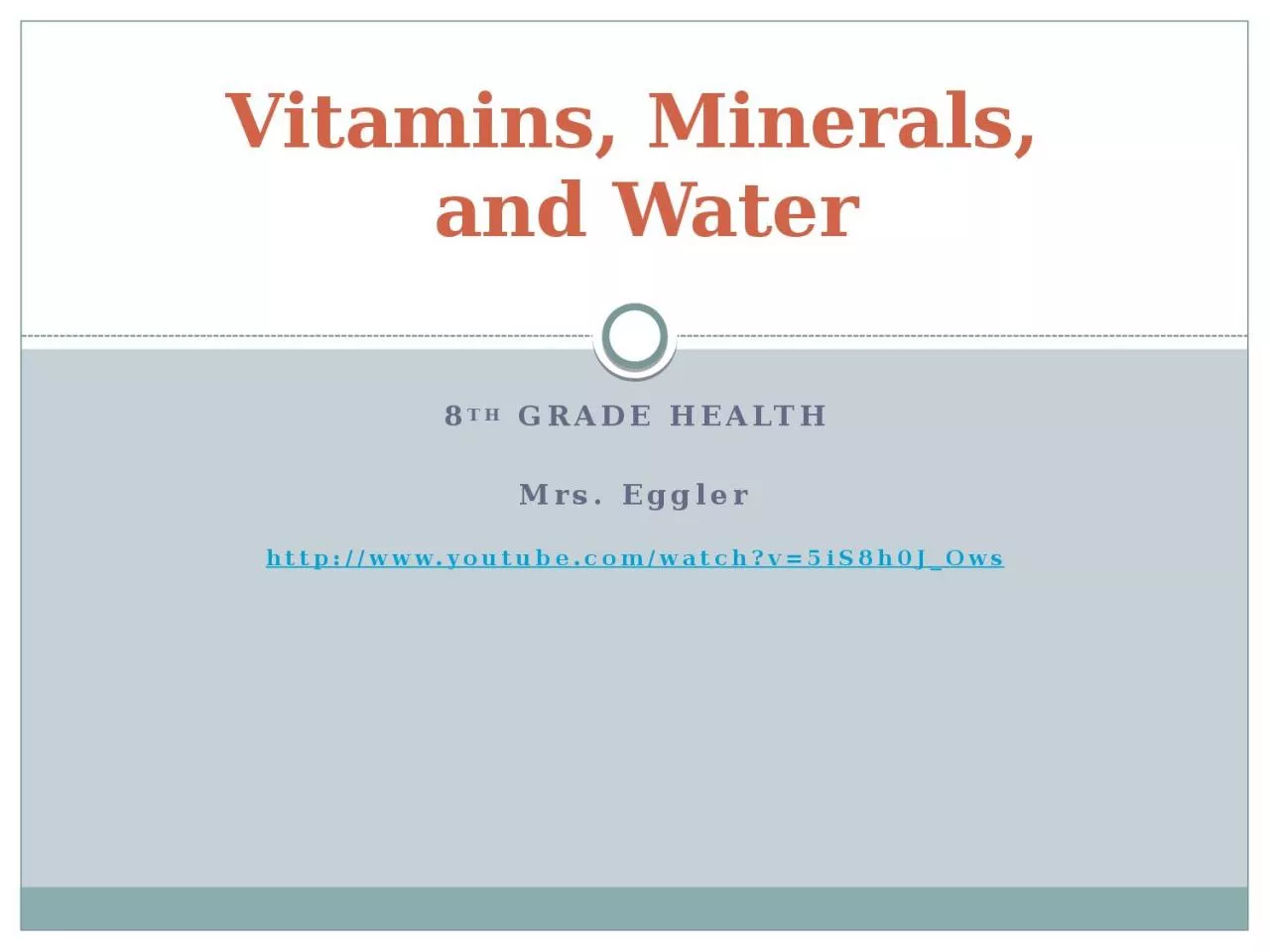

Eggler httpwwwyoutubecomwatchv5iS8h0JOws Vitamins Minerals and Water Opening Fact or Myth As part of a healthy diet people need to take dietary supplements A diet that contains a variety of healthful food usually supplies all the vitamins and minerals that your body needs ID: 1032669
Download Presentation The PPT/PDF document "8 TH GRADE HEALTH Mrs." is the property of its rightful owner. Permission is granted to download and print the materials on this web site for personal, non-commercial use only, and to display it on your personal computer provided you do not modify the materials and that you retain all copyright notices contained in the materials. By downloading content from our website, you accept the terms of this agreement.
1. 8TH GRADE HEALTHMrs. Egglerhttp://www.youtube.com/watch?v=5iS8h0J_OwsVitamins, Minerals, and Water
2. OpeningFact or MythAs part of a healthy diet, people need to take dietary supplementsA diet that contains a variety of healthful food usually supplies all the vitamins and minerals that your body needs.https://www.youtube.com/watch?v=DJ_NN2WdJBcSupplements: https://www.youtube.com/watch?v=XbQeIBbffrY
3. VitaminsNutrients that are made by living things are required only in small amounts, and that assist many chemical reactions in the body DO NOT provide DIRECT energy or the raw materials of which your cells are madeExample, Vitamin K: aids in clotting when you cut/scrape yourself
4. 2 Classes of VitaminsFat-Soluble-dissolve in fatty materialsWater-Soluble -dissolve in water
5. Fat-Soluble VitaminsVitamins A, D, E, & KCan be storedAbsorption through the digestive system: enhanced by dietary fatSome indigestible fats are used in low-fat or low calories products because extra vitamins are added (particularly vitamins A & D)
6. Fat-Soluble VitaminsVitaminGood SourcesMain FunctionALiver; eggs; cheese; milk; yellow, orange, and dark green vegetables and fruitMaintains healthy skin, bones, teeth and hair; aids vision in dim lightDMilk; eggs; liver; exposure of skin to sunlightMaintains healthy bones and teeth; helps in use of calcium and phosphorusEMargarine; vegetable oils; wheat germ; legumes; green, leafy vegetablesAids in maintenance of red blood cells, vitamin A, and fatsKGreen, leafy vegetables; potatoes; liver; made by intestinal bacteriaAids in blood clotting
7. Water-Soluble VitaminsInclude vitamin C and ALL B vitaminsUnlike Fat-Soluble, these canNOT be stored in the bodyTherefore it’s extremely important to eat a supply of them EVERYDAY
8. Water-Soluble VitaminsVitaminGood SourcesMain FunctionsB1 (Thiamin)Pork products; liver; whole-grains; legumesAids in carbohydrate use and nervous system functionB2 (Riboflavin)Milk; eggs; meat; whole grains; dark green vegetablesAids in metabolism of carbohydrates proteins, and fatsB3 (Niacin)Meat; poultry; fish; whole grains; nutsAids in metabolismB6 (Pyridoxine)Meat; poultry; fish; whole grains; green vegetableAids in metabolism of carbohydrates, proteins, fatsB12 (Cobalamin)Meat; fish; poultry; eggs; milk; cheeseMaintains healthy nervous system and red blood cellsPantothenic AcidOrgan meats; poultry; fish; eggs; grainsAids in metabolismFolate (Folic Acid)Green, leafy vegtables; legumesAids in formation of red blood cells and proteinsBlotinOrgan meat; poultry; fish; eggs; peas; bananas; melonsAids in metabolismC (Ascorbic Acid)Citrus fruits; green vegetables; melons; potatoes; tomatoesAids in bone, teeth, and skin formation; resistance to infection; iron uptake
9. AntioxidantsHelp protect healthy cells from the damage caused by the normal aging process as well as from certain types of cancerVitamins C & E are 2 of the most powerful antioxidantsExamples of C . . . .Examples of E . . . .
10. MineralsNutrients that occur naturally in rocks and soilYour body needs a very small amountPlants absorb minerals from rocks and soil through their rootsAnimals obtain these nutrients by either eating the plants or eating animals that have the plants24 different minerals have been shown to be essential for good health
11. MineralsYou need 7 minerals in significant amounts:1. Calcium2. Sodium3. Potassium4. Magnesium5. Phosphorus6. Chlorine7. SulfurOthers of minimal amount: iron, fluorine, iodine, copper, and zinc
12. CalciumMost people’s diet do NOT include enough calciumImportant for blood clottingImportant for nervous system functionEssential for formation and maintenance of teeth and bonesExamples of calcium . . . .
13. CalciumLack of calcium leads to . . . OSTEOPOROSIS!!!!!!!!!Osteoporosis is a disease that usually occurs in older adults however your calcium intake right now is VERY important to not getting Osteoporosis later in life.Your bones become brittle and break easily.Who is normally effected by this disease?
14. Activity Time!!!!!You will form your own groupsYou are creating a skit about explaining to another classmate how important CALCIUM intake isEVERYONE in the group needs to be included in the skit (A.K.A., EVERYONE performs in the skit)You must include at least 3 pieces of information from lecture notesAll language and content must be school appropriate
15. PotassiumPotassium and sodium work together to maintain balance in the bodyConsuming enough potassium = (in general) lower blood pressureExamples of potassium . . . . https://www.youtube.com/watch?v=5fJdQyGdlNE\https://www.youtube.com/watch?v=RHOK3HvvnVs
16. IronNecessary for healthy red blood cellsRed blood cells contain HEMOglobinCarries oxygen to different parts of the bodyAdolescent and adult women need extra iron due to menstruationBoth guys and gals in their teens need iron for building muscles
17. IronIf a person’s diet does not include enough iron, ANEMIA will occurCondition in which the red blood cells do not contain enough hemoglobin; people are often weak and tired and become sick easilyExamples of iron . . . .Cooked SpinachDried Apricots Lean beef
18. Iron ExamplesIron-fortified cereals (e.g., Kellogg's All-Bran & General Mills Total)
19. Iron ExamplesA salad containing garbanzo beans
20. SodiumMost people consume MUCH more than they needTable salt, a.k.a. sodium chloride, is a major mineral sourceExamples of salty foods . . . Important for functioning of the heart and water balanceToo much causes HYPERTENSIONHigh blood pressure
21. Water80% of your body is waterNot a direct energy providerNearly all of the body’s chemical reactions, including those that produce energy and build new tissues, take place in a water solutionPrimary component of blood and tissueHelps digest foodCarries waste out of the body
22. WaterHomeostasis: The process of maintaining a steady state inside your bodyWhen you become overheated, you perspire and cools your body = WATER regulates body temperatureDehydration:A serious deduction in body’s water content
23. WaterHow much water?Sport Drinks vs. Water